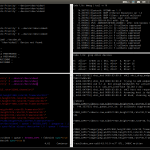For the last couple of days I’ve been investing time learning doing some (serious) things with Drupal and I quite like it, given that for my previous gig involving php I had to manually compile and patch php 5.2 in order to work with a monstrosity made with Textpattern and CakePHP (and a spice of hand crafted databased code).
Last morning I was almost ecstatic reading about Features and went on to make a new one just to try it out.
I select a few components, hit “Download feature” and after a while, nothing. Same happened with “Generate feature”.
On the error.log I see:
2014-10-29 07:49:31: (mod_fastcgi.c.2543) unexpected end-of-file (perhaps the fastcgi process died): pid: 11992 socket: unix:/tmp/php.socket-3
2014-10-29 07:49:31: (mod_fastcgi.c.3329) response not received, request sent: 1106 on socket: unix:/tmp/php.socket-3 for /some_site/index.php?q=admin/structure/features/create, closing connection
That was a bit odd, since the memory limit is set to an ample 256M and it died long before the time limt.
Just to be sure I tried using Apache instead of Lighttpd but no dice.
On the system log I see:
php-cgi[13015]: segfault at bf7c6fcc ip b738201a sp bf7c6fd0 error 6 in libpcre.so.3.13.1[b736d000+3f000]
With that clue I edit php.ini and shave a couple of zeros out of pcre.recursion_limit from the default of 100000. After restarting the server everything worked fine.
I shudder thinking of something that really needs a call stack 100 thousand levels deep. But on the other hand I cut my teeth on a micro with 68 bytes of ram.


